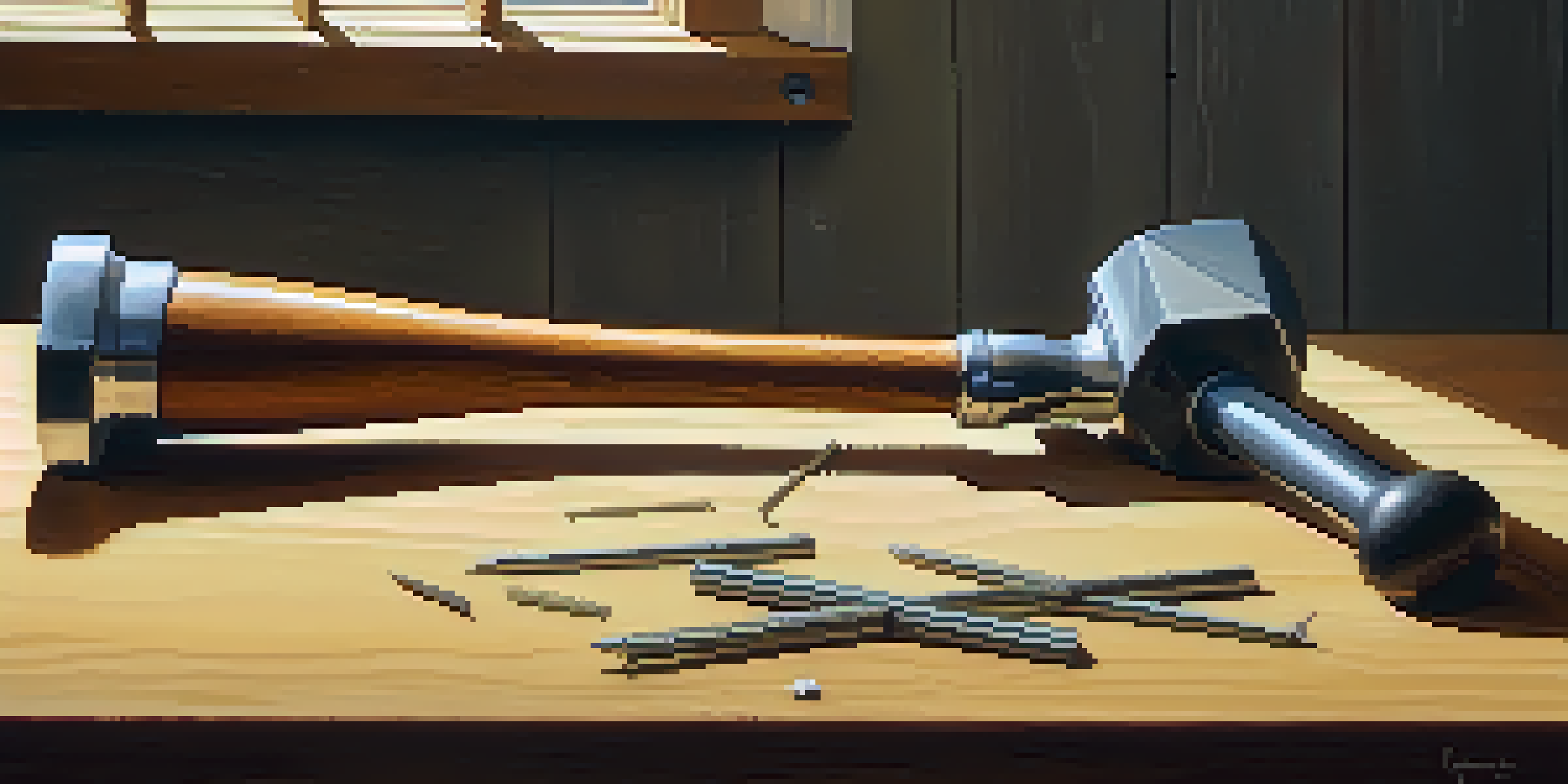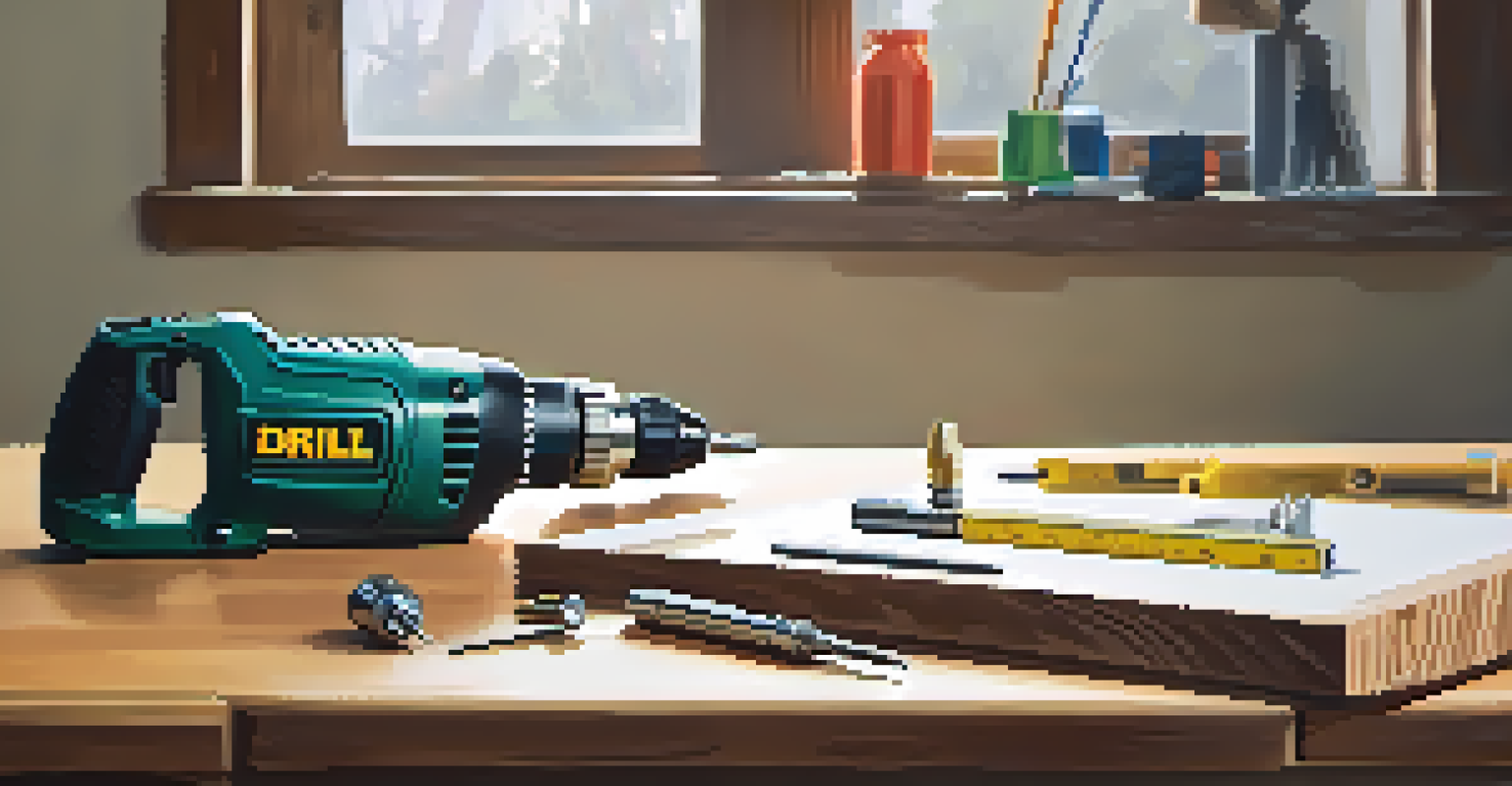Essential Tools for Homeowners: What Every DIYer Needs

The Versatile Hammer: A DIY Essential
A hammer is one of the most fundamental tools in any DIYer’s arsenal. Whether you're hanging pictures or assembling furniture, this trusty tool is crucial for driving nails with precision. With various types available, like claw hammers for pulling nails and sledgehammers for heavier tasks, you can find the right fit for your project.
Every tool is a weapon if you hold it right.
When selecting a hammer, consider the weight and handle material. A lighter hammer can reduce fatigue during extended use, while a rubber grip can enhance comfort and control. Remember, the right hammer not only makes your job easier but also ensures safety by providing better handling.
Finally, don't forget about the importance of technique! A firm grip, proper stance, and focused aim can significantly improve your results. With practice, you'll learn to swing with confidence, making your DIY projects more enjoyable and efficient.
A Reliable Tape Measure for Accurate Measurements
Accuracy is key in any DIY project, and a quality tape measure is essential for achieving that. Whether you're measuring wall space for new furniture or cutting materials for a project, having a reliable tape measure on hand can save you from costly mistakes. Look for one that locks securely and features both metric and imperial measurements for versatility.

When using a tape measure, remember to account for the hook at the end, which can affect your measurements. A good tip is to always measure from the inside edge of the hook for the most accurate reading. Additionally, using a tape with a wide blade can help prevent bending and make it easier to read measurements.
Essential Tools for DIY Projects
A well-rounded toolkit including a hammer, tape measure, and screwdriver set is vital for tackling various DIY tasks efficiently.
Investing in a durable, retractable tape measure can enhance your DIY experience. A sturdy case ensures longevity, while features like a built-in level can save you time and effort on the job. In the world of DIY, precision is everything, and a tape measure is your best friend.
Screwdriver Set: A Must-Have for Any Toolbox
No DIY toolkit is complete without a set of screwdrivers. These handy tools come in various sizes and types, perfect for tackling everything from assembling furniture to fixing loose cabinet doors. It’s a good idea to have both flathead and Phillips screwdrivers in your collection, as they accommodate different types of screws.
Measure twice, cut once.
When choosing screwdrivers, look for ones with comfortable, ergonomic handles. This not only makes them easier to use but also reduces strain during extended projects. Magnetic tips can also be a game-changer, as they help hold screws securely in place while you work.
Finally, consider investing in a multi-bit screwdriver. This versatile tool allows you to switch between different bits quickly, streamlining your projects. With the right screwdriver set at your side, you’ll be well-prepared for any assembly or repair task that comes your way.
The Power of a Cordless Drill for DIY Enthusiasts
A cordless drill is a game-changer for DIYers, allowing you to drill holes and drive screws with ease. This powerful tool saves time and effort, making it a staple for any homeowner looking to tackle projects around the house. With battery-operated options, you can move freely without being tethered to a power outlet.
When selecting a cordless drill, consider key features like battery life, weight, and speed settings. A lighter drill can help prevent fatigue during longer tasks, while variable speed settings give you better control for different applications. Additionally, look for a drill with a quick-change chuck to make switching bits a breeze.
Importance of Safety Gear
Investing in quality safety gear, such as goggles and gloves, is crucial for protecting yourself while working on DIY projects.
Finally, don't underestimate the value of accessories. A good set of drill bits and screwdriver attachments can significantly expand your drill's capabilities. With a reliable cordless drill in your toolkit, you'll find yourself ready to take on a variety of home improvement projects.
Pliers: Essential for Gripping and Cutting Tasks
Pliers are indispensable tools for any DIY enthusiast, providing the grip and leverage needed for various tasks. Whether you're bending wire, gripping small objects, or cutting through tough materials, a good pair of pliers can make a world of difference. Different types of pliers, like needle-nose and slip-joint, cater to specific tasks, ensuring you're equipped for anything.
When choosing pliers, pay attention to the grip and jaw design. A comfortable handle can enhance control, while a well-designed jaw ensures you can grip objects securely. Plus, look for pliers made from durable materials to withstand wear and tear during tough jobs.
Lastly, having a few pairs of pliers in different sizes can greatly improve your efficiency. Each type serves a unique purpose, and switching between them as needed can save time and effort. With the right pliers at your side, you'll be ready to tackle even the most challenging DIY tasks.
The Importance of a Level for Straight Installations
For any DIY project involving shelves, cabinets, or artwork, a level is a vital tool to ensure everything is straight and secure. It’s easy to forget how a slight tilt can affect the overall look and function of your installation. A level helps you achieve professional-looking results by indicating whether surfaces are perfectly horizontal or vertical.
There are various types of levels available, from traditional bubble levels to digital ones that provide precise measurements. Depending on your projects, you may choose a compact level for small tasks or a longer one for larger installations. The key is to select the right type that suits your specific needs.
Maximizing Accuracy with Levels
Using a level ensures that installations are straight, enhancing both the functionality and appearance of your projects.
Using a level is straightforward, but it’s essential to place it correctly on the surface you’re measuring. Keep an eye on the bubble or digital readout, and make adjustments as needed. With a trusty level in your toolkit, you can ensure that your projects are not only functional but also visually appealing.
Safety Gear: Protecting Yourself While DIYing
Safety should always be a priority when tackling DIY projects, and having the right safety gear is essential. From goggles to gloves, these protective items help shield you from potential hazards, ensuring that you can work confidently and efficiently. Investing in quality safety gear can make a significant difference in your overall DIY experience.
Consider the specific risks associated with your projects when selecting safety gear. For instance, if you’re working with power tools or handling sharp materials, a sturdy pair of gloves can protect your hands. Additionally, safety goggles will safeguard your eyes from dust and debris, allowing you to focus on your work without worry.

Lastly, don’t forget about hearing protection when using loud tools. Earplugs or earmuffs can help prevent long-term damage to your hearing. By prioritizing safety gear, you’re not just protecting yourself; you’re ensuring that your DIY projects are enjoyable and hassle-free.